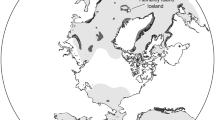Abstract
Here we document the addition of thousands of potentially amplifiable microsatellite loci (PALs) and associated primer sequences for public use. We conducted whole-genome shotgun sequencing to obtain ultra-low coverage, random genomic sampling from ten African and Asian squamate reptile species (representing ten genera). We used unique genomic processing methods and generated PALs for the following species: Acrochordus granulatus, Ahaetulla prasina, Cerberus rhynchops, Gonocephalus kuhlii, Ophiophagus hannah, Python bivittatus, Tribolonotus gracilis, Trimeresurus sabahi (Popeia sabahi), Uromastyx geryi and Varanus exanthematicus. All taxa included, as well as other related taxa not included in our study, are exploited heavily by the international skin and pet trades, yet researchers and conservation agencies currently lack substantial genetic resources for guiding conservation and management. Using stringent filtering methods, we generated between 467 and 8641 PALs for each of the ten species (52,164 PALs total), yielding a rich database of microsatellite loci and amplification primers for these taxa. In addition to the ten species targeted in our study, microsatellite markers provided in this database can likely be applied to a variety of closely related taxa that are also of conservation and commercial interest.
Similar content being viewed by others
References
Adams R, Blackman H, Reyes-Velasco J, Schield D, et al (2016) Microsatellite landscape evolutionary dynamics across 450 million years of vertebrate genome evolution. Genome
Alacs EA, Hillyer MJ, Georges A, Fitzsimmons JM et al (2009) Development of microsatellite markers in the Australasian snake-necked turtle Chelodina rugusa and cross-species amplification. Mol Ecol Resour 9:350–353
Castoe TA, Poole AW, Gu W, de Koning APJ et al (2010) Rapid identification of thousands of microsatellite loci for the copperhead snake (Agkistrodon contortrix) from modest amounts of 454 shotgun genome sequence. Mol Ecol Resour 10:341–347
Castoe TA, Hall K, Guibotsy Mboulas ML, Gu W, de Koning APJ et al (2011) Discovery of highly divergent repeat landscapes in snake genomes using high throughput sequencing. Genome Biol Evolu 3:641–653
Castoe TA, Streicher JW, Meik JM et al (2012a) Thousands of microsatellite loci from the venomous coralsnake (Micrurus fulvius) and variability of select loci across populations and related species. Mol Ecol Resour 12:1105–1113
Castoe TA, Poole AW, de Koning APJ et al (2012b) Rapid microsatellite identification from Illumina paired-end genomic sequencing in two birds and a snake. PLoS ONE 7:e30953
Castoe TA, de Koning APJ, Hall KT, Card DC et al (2013) The Burmese Python genome reveals the molecular basis for extreme adaptation in snakes. Proc Natl Acad Sci 110:20645–20650
Ghobrial L, Lankester F, Kiyang JA, Akih AE et al (2010) Tracing the orgins of rescued chimpanzees reveals widespread chimpanzee hunting in Cameroon. BMC Ecol. doi:10.1186/1472-6785-10-2
Iyengar A (2014) Forensic DNA analysis for animal protection and biodiversity conservation: A review. J Nat Conserv 22:195–205
Knapp A (2004) An assessment of the international trade in Spiny-tailed Lizards Uromastyx with a focus on the role of the European Union. TRAFFIC Europe Report
Koch A, Ziegler T, Bohme W, Auliya M (2013) Pressing problems: distribution, threats, and conservation status of the monitor lizards (Varanidae: Varanus spp.) of Southeast Asia and the Indo-Australian archipelago. Herpetol Conserv Biol 8:1–62
Natusch DD, Lyons J (2012) Exploited for pets: the harvest and trade of amphibians and reptiles from Indonesian New Guinea. Biodivers Conserv 21:2899–2911. doi:10.1007/s10531-012-0345-8
Sambrook J, Russell DW (2006) Fragmentation of DNA aby nebulization. In: Sambrook J, Russell DW (eds) “Commonly Used Techniques in Molecular Cloning,” Appendix 8, in molecular cloning, vol 3, 3rd edn. Cold Spring Harbor Laboratory Press, Cold Spring Harbor (2001)
Schoppe S (2009) Status trade dynamics and management of the Southeast Asian box turtle in Indonesia. TRAFFIC Southeast Asia
Shaney KJ, Wostl E, Hamidy A, Kurniawan N, et al (2016) Conservation challenges regarding species status assessments in biogeographically complex regions: examples from overexploited reptiles of Indonesia. Oryx
Vonk FJ, Casewel NR, Henkel CV, Heimberg A et al (2013) The king cobra genome reveals dynamic gene evolution and adaptation in the snake venom system. Proc Natl Acad Sci 10:20651–20656
Wasser SK, Shedlock AM, Comstock K, Ostrander EA et al (2004) Assigning African elephant DNA to geographic region of origin: Applications to the ivory trade. Proc Natl Acad Sci 101:14847–14852. doi:10.1073/pnas.0403170101
Zucoloto RB, Villela PMS, Verdade LM, Coutinho LL (2006) Cross-species microsatellite amplification in South American Caimans (Caiman spp and Paleosuchus palpebrosus). Genetics and Molecular Biology 29:75–78
Acknowledgments
We are grateful to representatives of LIPI at the Museum Zoologicum Bogoriense for facilitating the study of specimens from Indonesia and providing field research permits, namely Boadi, M. Amir, R. Ubaidillah, I Sidik, and Ir. R. M. Marwoto. We are grateful to the Ministry of Research and Technology of the Republic of Indonesia (RISTEK), for coordinating and granting research permissions. Pak S. Wahyono (RISTEK) provided assistance throughout the permitting process. RISTEK and LIPI reviewed and approved our fieldwork in Indonesia and provided export permits for specimens to the United States for study and deposition at UTA. W. Trilaksono, I. Sidik, and A. Ryanto provided laboratory assistance at MZB. Mr. Widodo and Marwoto from the Faculty of Mathematicas and Natural Sciences of Universitas Brawijaya (MIPA-UB) kindly provided logistical support. The Forestry Department of Indonesia provided research permits for areas under their jurisdiction. We thank the local communities for their support, advice and kindness during our travels. We thank the members of the field expeditions throughout Java and Sumatra: G. Barraza (Broward College); U. Arifin (Institut Teknologi Bandung), W. Trilaksono (MZB); C. Franklin, K. O’Connell, U. Smart, E. Wostl (UTA), and A. M. Kadafi, D. R. Wulandari, R. Darmawan, K. I. Nawie, A. Dharasa, and S. Pratassi (MIPA- UB). Funding was provided by a National Science Foundation Grant (DEB-1146324) to E. N. Smith and M. B. Harvey, and startup funds to T. A. Castoe.
Author information
Authors and Affiliations
Corresponding author
Rights and permissions
About this article
Cite this article
Shaney, K.J., Adams, R., Kurniawan, N. et al. A suite of potentially amplifiable microsatellite loci for ten reptiles of conservation concern from Africa and Asia. Conservation Genet Resour 8, 307–311 (2016). https://doi.org/10.1007/s12686-016-0534-y
Received:
Accepted:
Published:
Issue Date:
DOI: https://doi.org/10.1007/s12686-016-0534-y




